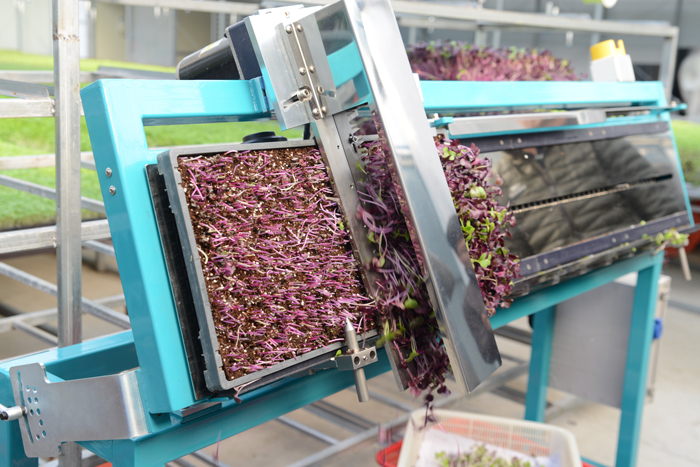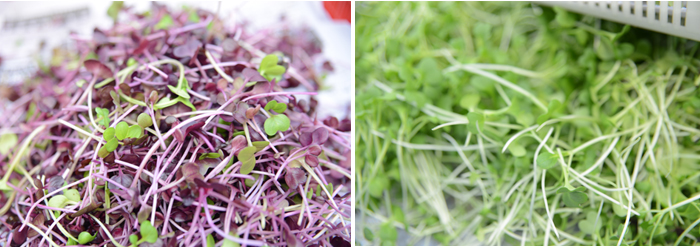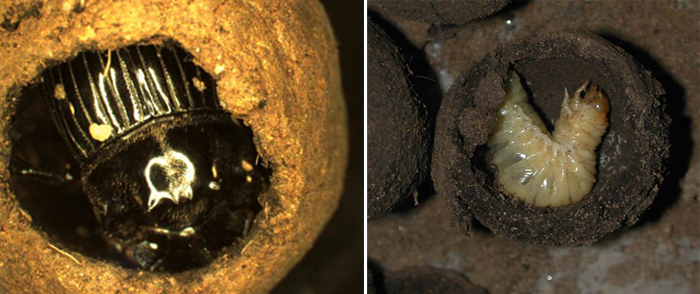Sprouts that are consumed within four days of sprouting have been a popular dish since the early 2000s. Consumers seem to have been attracted to the merits of both its safety as well as richness in vitamins and minerals, in comparison with more ripened sprouts. However, the sprouts require particular growing conditions and thus there has always been more demand than supply.
In a bid to address these difficulties, the Rural Development Administration (RDA) recently developed a new machine that helps farmers to cultivate sprouts in a much easier, faster and more convenient manner.
The new system works as follows. Put the seedbeds of fully-grown sprouts into the machine. The cutter moves from side to side along the conveyor belt, snipping off the sprout branches. These are then funneled into a collecting box underneath.


The speed of both the conveyor belt and cutting mechanism, as well as the angle of the seedbed, can be adjusted depending on the type and condition of the plants. It has also been designed to separate the sand in the seedbed from the harvestable sprouts.
With the use of the new machine, farmers are expected to harvest between 300 and 600 seedbeds per hour. The time consumed by harvesting can be reduced by as much as 70 percent when compared to the previous manual handling method.
RDA researcher Lee Si-yeong said, “We started researching the sprout harvest system in 2010, invented this new machine in 2012 and eventually conducted practical field tests in the farms last year.” Lee explained that the traditional method is both time consuming and energy consuming and so the new automatic system will gradually gain popularity. “The new machine is expected to spread across the country by 2015,” Lee added.
Separately, an RDA-developed cosmetic which uses the insect peptide coprisin has also been getting a lot of attention.
Coprisin is a natural peptide consisting of 43 amino acids made by the Copris tripartitus beetle. The peptide has anti-microbial elements that are good for skin health. The RDA has now released three cosmetic lines using this beetle peptide: a repair cream, a nutritional clinic and an aqua-mask.

The bio-defensive material has antibiotic ingredients that can fight off harmful bacteria, such as oral bacteria and Propionibacterium acne. In addition, it is believed to be effective in controlling resistant bacteria, too.
The coprisin research has been recognized by the government as one of its most successful research projects in 2013. The RDA is now discussing various applications for this research, including cosmetics, anticancer medicines and food preservatives, as well as its overall commercialization.
RDA researcher Hwang Jae-sam said, “This is the first time that an insect’s bio-defense material has successfully transformed itself into a dermatotropic substance. We believe that more research on insects would possibly bring more science to rural development.”
By Lee Seung-ah
Korea.net Staff Writer
slee27@korea.kr
In a bid to address these difficulties, the Rural Development Administration (RDA) recently developed a new machine that helps farmers to cultivate sprouts in a much easier, faster and more convenient manner.
The new system works as follows. Put the seedbeds of fully-grown sprouts into the machine. The cutter moves from side to side along the conveyor belt, snipping off the sprout branches. These are then funneled into a collecting box underneath.


The RDA’s new machine helps to cultivate sprouts in a much easier, faster and more convenient manner. (photos courtesy of the RDA)
The speed of both the conveyor belt and cutting mechanism, as well as the angle of the seedbed, can be adjusted depending on the type and condition of the plants. It has also been designed to separate the sand in the seedbed from the harvestable sprouts.
With the use of the new machine, farmers are expected to harvest between 300 and 600 seedbeds per hour. The time consumed by harvesting can be reduced by as much as 70 percent when compared to the previous manual handling method.
RDA researcher Lee Si-yeong said, “We started researching the sprout harvest system in 2010, invented this new machine in 2012 and eventually conducted practical field tests in the farms last year.” Lee explained that the traditional method is both time consuming and energy consuming and so the new automatic system will gradually gain popularity. “The new machine is expected to spread across the country by 2015,” Lee added.
Separately, an RDA-developed cosmetic which uses the insect peptide coprisin has also been getting a lot of attention.
Coprisin is a natural peptide consisting of 43 amino acids made by the Copris tripartitus beetle. The peptide has anti-microbial elements that are good for skin health. The RDA has now released three cosmetic lines using this beetle peptide: a repair cream, a nutritional clinic and an aqua-mask.

The Copris tripartitus beetle (photos courtesy of the RDA)
The bio-defensive material has antibiotic ingredients that can fight off harmful bacteria, such as oral bacteria and Propionibacterium acne. In addition, it is believed to be effective in controlling resistant bacteria, too.
The coprisin research has been recognized by the government as one of its most successful research projects in 2013. The RDA is now discussing various applications for this research, including cosmetics, anticancer medicines and food preservatives, as well as its overall commercialization.
RDA researcher Hwang Jae-sam said, “This is the first time that an insect’s bio-defense material has successfully transformed itself into a dermatotropic substance. We believe that more research on insects would possibly bring more science to rural development.”
By Lee Seung-ah
Korea.net Staff Writer
slee27@korea.kr
